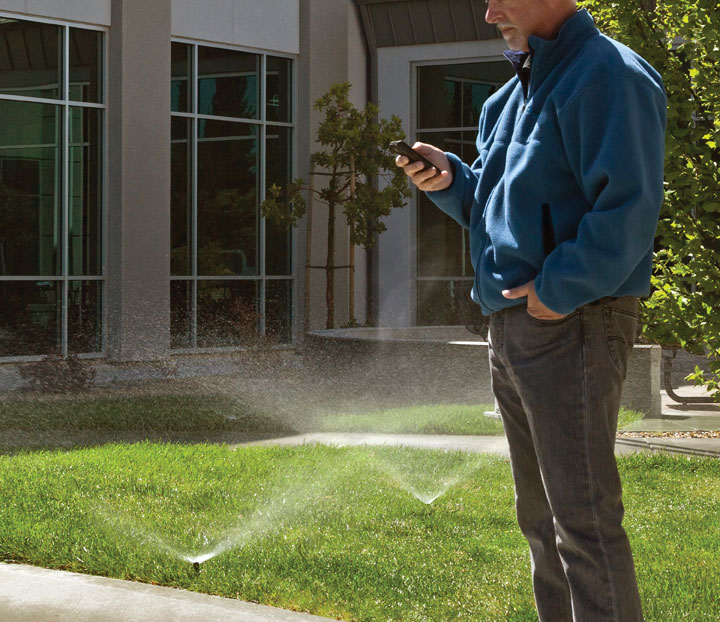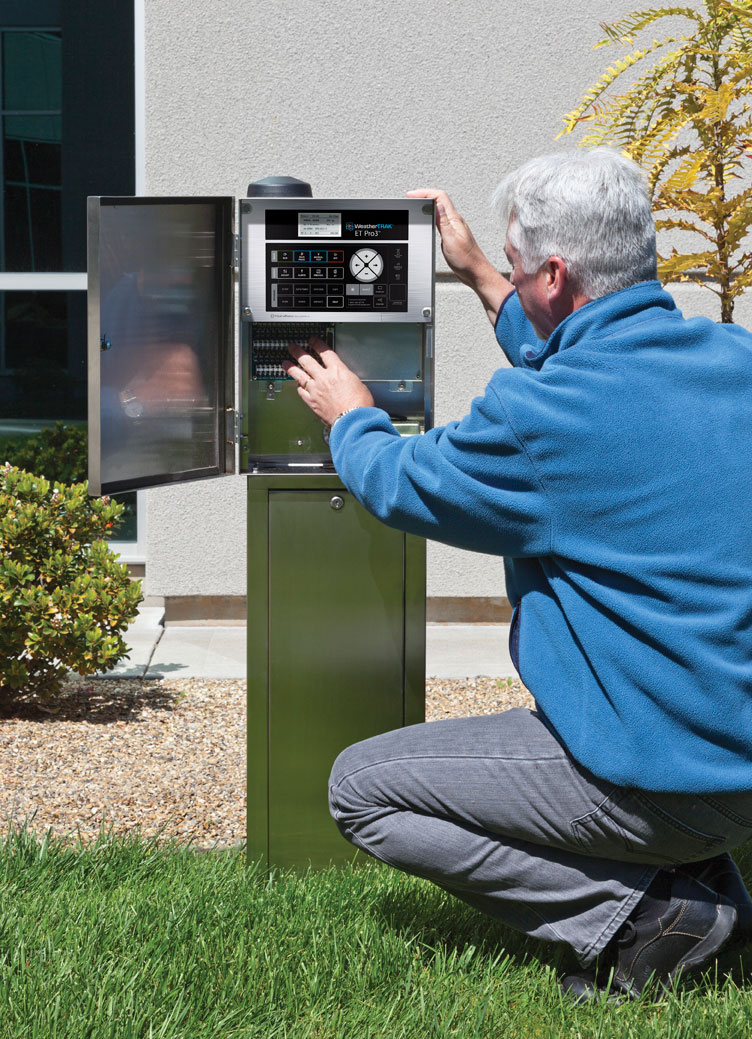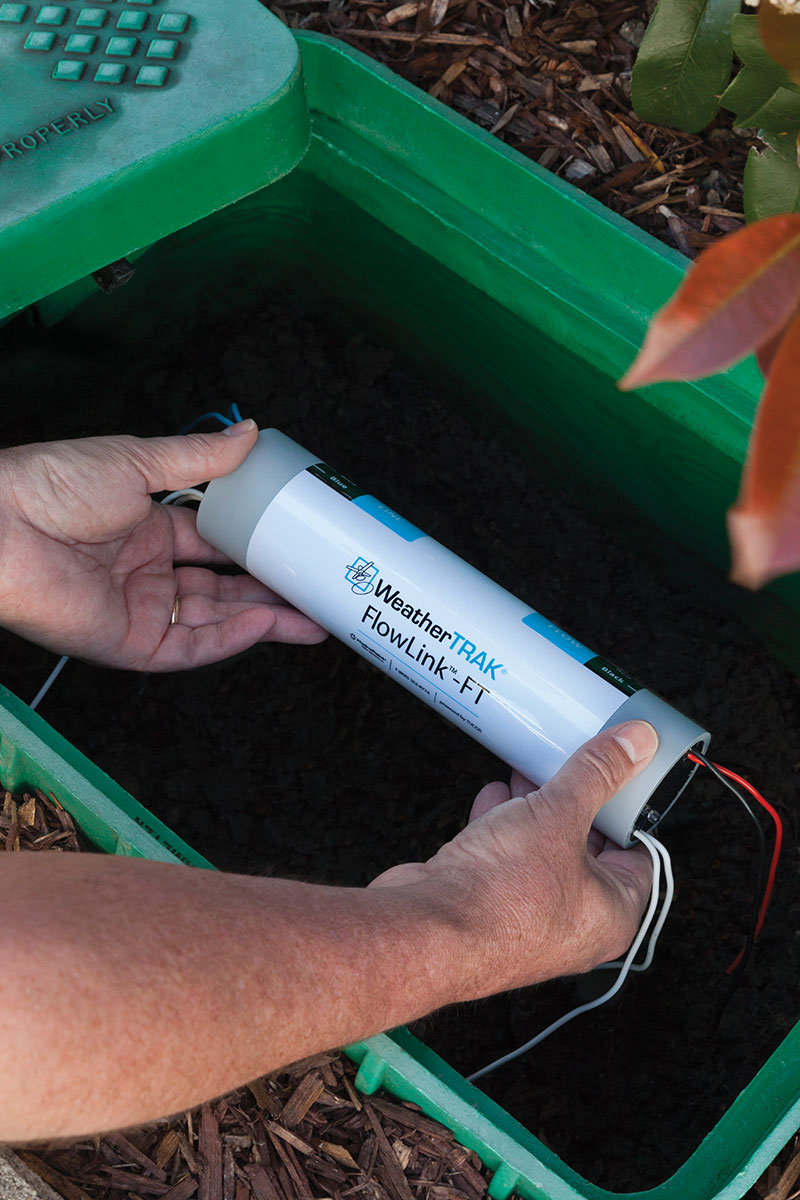What’s in ‘store’ for smart landscape irrigation?
BY CHRIS SPAIN
Last year [2014] was a big year for smart landscape irrigation as the cost of water continued to increase, overwatering-related costs were further understood, and retail-related property owners and managers continued to realize that landscapes required not just landscape services but also “water management.” With more and more contractors relying on smart irrigation to ensure healthy landscapes and happy customers, and organizations seeing first-hand how they can capitalize on this low hanging fruit in sustainability, the big question now becomes what’s next for this ‘new’ technology?
LEARNING FROM THE PAST
Before predicting the future, it’s important to see how smart irrigation systems have evolved in past years. Of course, the main driver for ‘smarter’ irrigation has always been water scarcity but once property owners and managers started to look at outdoor water management, they quickly realized that landscape overwatering, something happening 30% to 300% of the time, was the gift that kept on taking. Overwatering was not just pouring money down the drain but excess watering and landscape-related leaks were the cause of significant structural and plant damage, not to mention increased liabilities and exposure due to an ever-changing array of fines and compliance violations ranging from time-of-day watering to excessive runoff. This brought a major change to the green industry and what it meant to ‘manage’ a landscape.
 The changes have been far-reaching and rich with opportunities but also filled with risk. Landscape maintenance contractors were now at the heart of an environmental balancing act, forced to balance customers’ expectations of landscape beauty with overall health, water scarcity, costs, time and water agency regulations. Combine that with the organization’s lack of knowledge and access to water usage reports, the fact an irrigation system failure could, in one night, wipe out a month’s worth of water savings, and the significant increase in labor costs associated with enhanced water management, a real demand was created for a more advanced landscape irrigation solution.
The changes have been far-reaching and rich with opportunities but also filled with risk. Landscape maintenance contractors were now at the heart of an environmental balancing act, forced to balance customers’ expectations of landscape beauty with overall health, water scarcity, costs, time and water agency regulations. Combine that with the organization’s lack of knowledge and access to water usage reports, the fact an irrigation system failure could, in one night, wipe out a month’s worth of water savings, and the significant increase in labor costs associated with enhanced water management, a real demand was created for a more advanced landscape irrigation solution.
FIRST GENERATION CONTROLLERS
When smart irrigation first came to market, it was about putting the right amount of water at the right place at the right time… in the right way. The dream was that one could install a smart controller, set the controller to the ‘smart’ setting, and like magic, the site would instantly transform from water waster to water saver.
The reality was a bit more complicated and for some, an outright nightmare. Water reductions exposed legacy issues in the existing irrigation system which, if not addressed, would either stress the landscape or severely limit what could be saved. And if there was a failure somewhere in the irrigation system and the weather was severe, contractors now had little time to react before damage occurred. While the first generation of smart controllers showed that weather-based irrigation was an improvement over a simple timer for eliminating water waste, for many of the industry’s best contractors, their smart irrigation sites still had mixed results and, worse yet, many still wasted water and in turn created disappointed customers.
TWO-WAY WIRELESS TO THE RESCUE
The second generation of smart controllers was made possible when two-way wireless communications became affordable and ubiquitous. The ability to communicate with these controllers in real time and to operate and ‘see’ hundreds and even thousands of stations and flow sensors from a central, remote location without having to set up and maintain complicated and temperamental radio systems gave new meaning to ‘smart.’ For the first time, it was now possible for contractors managing both large and small sites to be automatically alerted as landscape issues happened and for some controllers to even be able to remotely test and verify the issue before making a costly trip to the site. What was missing, however, was the chance to get ahead of the problem and be proactive vs. being dragged from one emergency to another.
 2014: A BIG YEAR FOR SMART IRRIGATION
2014: A BIG YEAR FOR SMART IRRIGATION
With the Internet of Things (IoT) and cloud technology in full swing (not to mention severe drought conditions hitting most of the country), 2014 was the year next generation smart controllers really took off. ‘Smart Irrigation’ wasn’t just efficient irrigation scheduling — it was also about using data and the knowledge the data provided to help organizations make their sites and businesses smarter. Whether it was water budgeting tools, integrated site survey applications, smart phone apps, or water savings reports, the goal was the same. This next generation of smart controllers became not just about getting the right amount of water to the right place at the right time but now it meant getting the right piece of data to the right person at the right time. For example, here’s a quick look at how some customers have been benefiting from this evolution in smart landscape irrigation:
• Walmart: After installing smart controllers at new stores and retrofit sites across the country, they cut water use by 39% on average per site while gaining critical remote access and visibility for property managers, landscape contractors and company executives.
• Regency Centers: To combat overwatering and reduce outdoor water consumption in 11 states with high water rates, they installed more than 165 smart controllers, saving more than 96 million gallons of water and more than $350,000 in water and operating expenses annually.
• Forest City (at the Galleria at Sunset shopping center in Las Vegas): Smart controllers delivered 29% water savings in less than 9 months while helping them still maintain a beautiful landscape to attract shoppers.
 WHAT’S NEXT?
WHAT’S NEXT?
Where does the technology go from here? Based on our more than 12 years in the business, we see the following five key system trends:
1. Advancements in flow installation options and sensors: With real-time flow data, smart irrigation controllers are at their smartest, making it possible to identify leaks, system breaks, controller setting errors, and even water theft. However, many flow sensors lose accuracy at low flow rates which can lead to inaccurate readings for low flow systems such as drip irrigation. Look for affordable retrofit flow solutions and higher resolution flow sensors that accurately measure flow systems, minimize costs, require less space and make installation debugging straightforward.
2. Retrofit solutions: The biggest water-wasting sites are often the oldest, usually because of numerous legacy issues making accurate and comprehensive site surveying systems critical. Look for site survey solutions that upload site data directly into the smart controller’s web site and that help identify and prioritize which system issues to address first.
3. Site monitoring: No matter how smart the fire alarm is, if no one is around to respond, the fire doesn’t get put out. Site monitoring services allow property owners and managers who do not have a support team to still realize the full potential of their smart water management system. Look for services that include site issue escalations, repair authorization services, and site savings performance analysis.
4. Water budgeting calculators: The first step to saving and to reaching mandated usage is having a budget. Look for water budgeting applications alongside smart controllers that incorporate flow data directly from the controller’s flow sensor and/or allow water bill importing. When analyzing year over year success, do not forget to factor in weather changes and be sure the weather data you use is site specific.
5. Improved data access: Many companies have smart building systems that can benefit from the incorporation of a site’s outdoor water data. Look for a smart water management ‘platform’ that integrates with these systems allowing the two to ‘talk’ and share critical data.
2014 may have been a big year for smart landscape irrigation but 2015 and beyond promises to deliver even more. 2015 is the year to attack your water wasting sites and to start saving water, time and money while helping your organization get ‘smarter’ about one of our most precious resources.
— Chris Spain is CEO and president of Hydropoint Data Systems, makers of the WeatherTRAK™ smart water management system.
